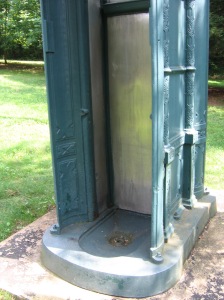
Ned Pelger's blog on construction, design and other weirdness. Email him at ned@constructionknowledge.net
Please help him win his readership competition against his son Lex at the Construction Phone Apps Blog
A friend’s friend’s son works as Construction Superintendent on this beautiful bridge project and they sent me these photos. This $160M project was under construction last year when TBW and I toured Hoover Dam. They’ve made substantial progress since then and seem to be nearly completion.
The 53 concrete arch sections (each 24′ long) have been cast on site and lifted into place. The steel cables supporting the concrete are temporary and will be removed when the arch connects and starts to act like an arch.
This $160M seems like a reasonable investment for America to make. The traffic flow between Nevada and Arizona will substantially improve and the Hoover Dam will be more easily protected from terrorist shenanigans.
As I watch the health care bill proceed in a total bipartisan battle, I wonder if America can agree on any big issues anymore. Could we build the interstate highway system if we were starting now? Could we design and build the power plants and chemical plants that have helped us prosper?
Looking towards the New Year, I’m going to try to be less of a bonehead, not always needing to get my own way. If we all work at giving in on the non-essentials (which are about 98% of the things in our life), maybe we can start moving America back towards getting big and important things done.
Here’s a last look at one of those big and important things:
I haven’t shown any cool projects lately and was entranced by these photos of an underground house in Switzerland. Being mostly dog-like, I have always felt comfortable in little nooks, dens and caves. Our son Lex most have inherited this trait. We once visited him house sitting this huge apartment in NYC and he chose to live in a small closet that held his books, blankets and him. The fact that he was too cheap to pay for heat and could heat the closet with his body had something to do with that decision as well.
Anyway, I love the photos shown below and would certainly try and visit this house if I was in the area.
If you want to see more photos of this incredible house, follow this link.
My good friend Holmes just visited Dubai on business. He and I have been friends since we met on the school bus in 7th grade and it’s always great to catch up with him. From him I developed the theory of “The Scent”. There was a pretty eighth grade girl with big brown eyes and built, as we said in those days, like a brick shithouse. I couldn’t understand how this girl liked Holmes and not me. In fact, lots of the girls seemed to have a special place for Holmes. I determined that he had “The Scent”.
He put off some sort of charming chemical that weakened knees. Since he still manages to charm his way through crazy situations all over the world, I believe even more strongly in my Scent theory. His wife of about 30 years grudgingly agrees. He and I were in each other’s weddings and have stayed friends through the good, the bad and the not so pretty.
But I digress. Dubai continues to fascinate me. The biggest construction boom in history has just ended there as it appears the bubble has burst. Holmes sent me a couple of photos.
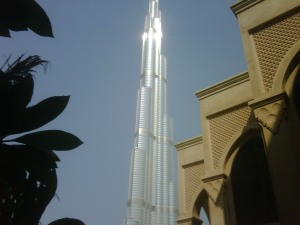
This was the view Holmes had as he walked out of his hotel. Wow! I really can’t imagine what it would be like to work on a project of that scale.
The photo below he captioned with, “More hotels, not sure who’s going to stay in them, though.”
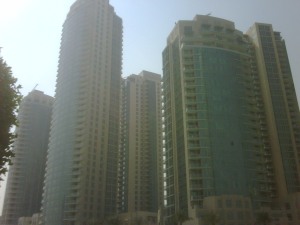
Right now, I’m liking my nice little business that keeps me busy building fun projects with great people. Life is good.
We had dinner with Randy and Dee Miller in Lititz last night and saw an amazing Manspace. Randy’s back story is about as impressive as it gets. Coming from a poor family with a Mom who had never been able to attend school, Randy started working at 9 years old. By 11 years old he had developed a shoe shine business and was renting a small shoe shine shop on Main Street. Besides shining the shoes of passersby, he also had most of the town’s doctors let him into their houses on a Saturday afternoon to keep their shoes shined as well.
Randy endured a serious of tragedies that go beyond the scope of this post. Let’s just say that Job and Randy could talk. Like Job, Randy persevered and prospered. Eventually he saw a niche in delivering water softener salt directly to people’s houses and built a strong business from that concept. At 73, Randy has retired from that business but kept his love of Lititz.
He’s collected Lititz memorabilia for decades. He took the basement of his beautiful home and created a Lititz Museum that simply delights. He has part of the old Lititz bowling lanes (along with the neon sign), an exact replica of his old shoe shine stand, and all kinds of working toys and mementos from times gone by. He created a Manspace around his passions and adds to it regularly.
To learn more about this fun concept of Manspaces, watch the following short TED video:
[youtube=http://www.youtube.com/watch?v=F7oT1gXo5eA&feature=youtube_gdata]
Do you have a Manspace? What would you build if you could? I’m thinking about a bunch of limestone piles in a circular wall around a tree in the woods behind my house. I’m not sure why…
Have you ever had the opportunity to work on any novelty architecture projects? It’s fun and challenging to get out of the norm of construction and work on some odd ball projects. This Appetizing Architecture post shows lots of fun food buildings and structures. A few photos below give you a taste…
Like a drive through donut shop in (where else?) California
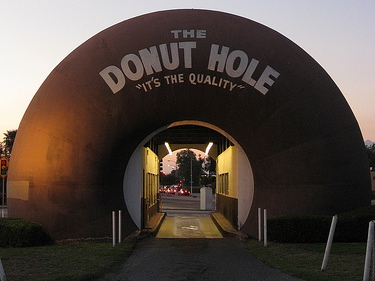
Or a giant milk bottle ice cream stand in Boston.
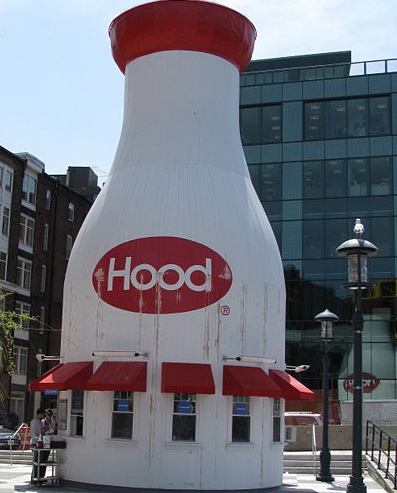
The Longaberger Basket building below is a much more substantial project. Built over 10 years ago, the corporate office building became a tourist destination for Longaberger basket devotees. This project really helped build their brand.
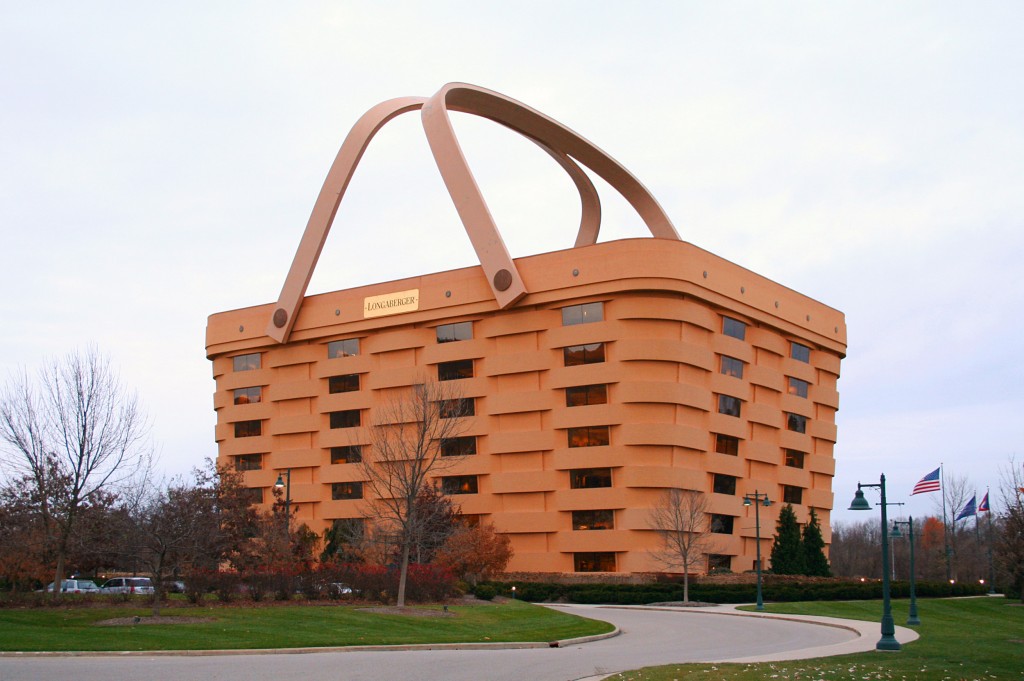
Most of us aren’t going to get to work on projects this wacky, but we may have some fun things come our way. I did an Isaac’s Deli building a few years ago and had to figure out how to design and build a steel gull wing sculpture/canopy above the entrance.
At the time, it seemed like one more thing to do during a busy time. It didn’t feel like a fun challenge, it was a pain, something that took time I didn’t think I had. I look back, though, with fondness and a bit of nostalgia.
As you struggle this week, doing more than you think you can get done. Take a moment to stop and appreciate the fact that you get to do some challenging work. Look back on some things you’ve completed and let yourself feel good about your accomplishments. This is your life, baby, enjoy it.
Mark Twain said, “It is a little thing – glass is – until it is absent, then it becomes a big thing.” As I stood on the clear glass floor at the Corning Glass Museum, I read the quote and thought of all the times glass becomes a big thing. When a window breaks on a cold night, when you live/work in a space without natural light, when you stand on a glass floor.
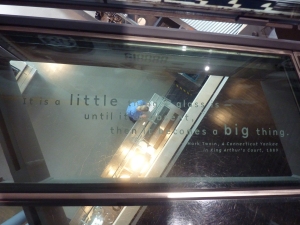
Then I thought I was glad TBW didn’t wear a skirt today. We were touring the amazing Corning Glass Museum in Corning NY. If you have a chance to visit, I highly recommend it. They spent $65M on a cool industrial style building that teaches and delights.
For example, we all know that fiber optic cable carries more data (bandwidth) than copper wire. Do you have a sense how much more? The fiber optic cable is the size of light nylon fishing line. The photo below shows how much copper wire carries the same amount of data as a single fiber optic wire (about 8′ diameter).
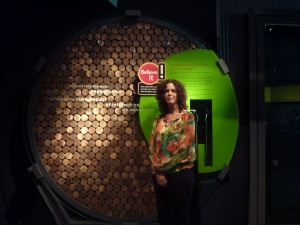
Another thing I liked about the Glass Museum was how well they involved us in hand’s on projects. We watched several demonstrations of glass experts making some great artistic and functional pieces. They start working with this honey like substance and end with these beautiful creations. It’s one thing to watch others work the glass, it’s another experience entirely to make a piece yourself. We enjoyed getting to start with molten glass and end with some nice pieces.
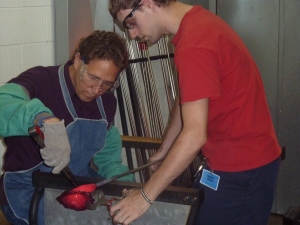
Of course, We also loved seeing the museum glass pieces. What a delightful day, to wonder and wander, appreciating the creativity of others. If you don’t visit museums, you should consider it. See photo below for example motivation. And yes, I do realize my mind tends to be of the one track variety.
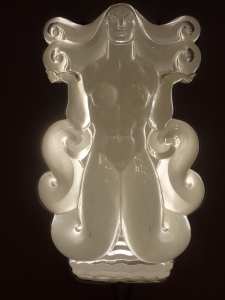
I love water features, fountains and sculptures. The flowing of water mesmerizes me. I stumbled across a website UPHAA: All Things Around the World that has some beautiful water sculptures. Have you ever had a chance to design or build a cool water feature? I thought I was going to on a current project, but we ended up just putting a big rock there instead (bless my practical little heart). So I continue to appreciate what others have done.
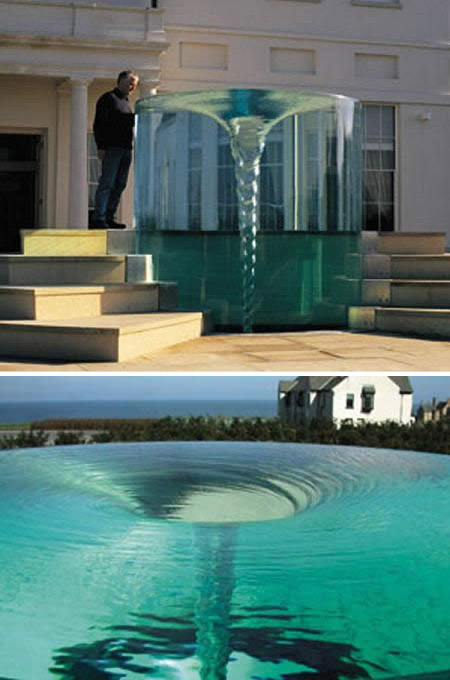
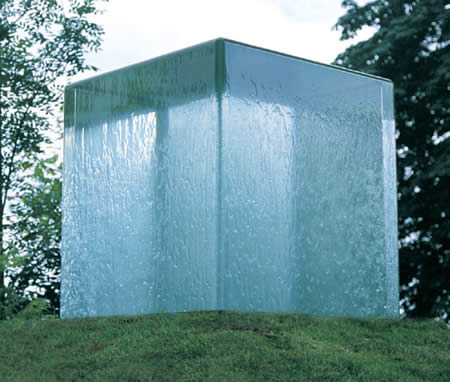
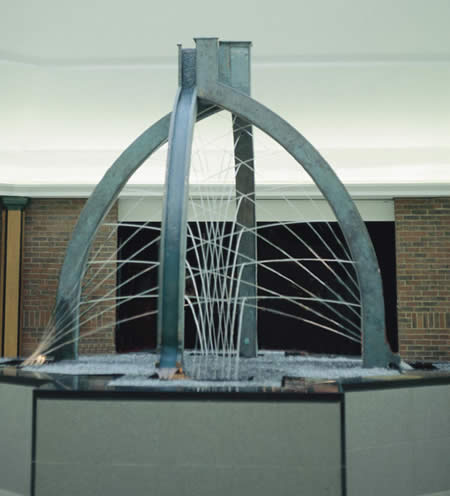
The video below is less than a minute and really worth watching if the water vortex fascinates you.
[youtube=http://www.youtube.com/watch?v=XxvHVREQogY&feature=player_embedded]
I rode bicycle yesterday in Lance Armstrong’s LiveStrong Philadelphia Cancer Ride. As I tortured myself through 70 miles of heat on legs that haven’t ridden much this summer, I talked to several folks who dealt with cancer up close and personal. The resiliency of people encourages me to try a bit harder in my day to day living.
Today I read about Bab Gerding dying at 71 after a long struggle with cancer. You may have heard of Bob, he transformed the Portland OR downtown area with many eco-friendly high rise buildings. His firm worked private-public partnerships for the benefit of many. Since 1994, they designed and built mixed use buildings that conserved energy and water.
Before most folks talked about sustainable or green design, they developed projects that just made sense. In fact his firm, Gerding Edlen Development Co., produced more LEED certified buildings than anyone else in the world at one point.
Bob’s Dad was a residential contractor in Oregon, but Bob went to university and studied biochemistry. He eventually got his PhD and held a clinical post at Good Samaritan Hospital, in Portland. He discovered he liked building labs better than running them, though, so started into his new career.
He defied the stereotypes of developers. While making a fair profit, he consistently tried to bring the best for all the stakeholders. He and his wife also loved the arts and supported them with generosity and time.
As I read about the life of Bob Gerding and the lives he touched, I’m challenged to live with conviction and purpose. You only live once, but if you make the right choices, once is enough.
The Beautiful Wife and I went west this past weekend with a couple of friends to tour Frank Lloyd Wright houses. Since Fallingwater is only a few hours away, we’ve visited it many times over the years. It’s such a perfect jewel of a house. The American Institute of Architects named the house “the best all-time work of American Architecture.” TBW and I are shown below at the money shot for Fallingwater.
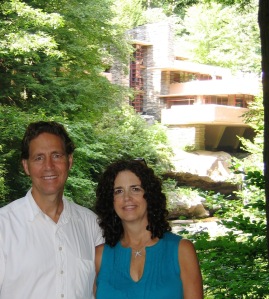
Every time I visit Fallingwater, another aspect of the design shines out to me. This time the flagstone floors amazed me. Somehow I felt like I was walking barefoot in a a stream.
As I studied the construction sequence of the house, I learned Frank Lloyd Wright wasn’t on site much. Most of the real decisions, then, were made by the contractors, material suppliers and the young on-site architect who worked for Wright. I can imagine this team working through challenging details, trying to get to the best, reasonable solution.
Our teams often work that way on projects and it’s the most rewarding aspect of building. Yet we all need to bring more than just our own specific expertise to get to great solutions. We all should bring a context of beauty and excellence. We get that context by seeing it in other places.That’s why I take time to visit beautiful buildings and bridges and encourage you to do the same.
The Kentuck Knob house that Wright designed a few miles down the road from Fallingwater also stirs me. Wright wanted to change the way Americans live. He hated that people lived in ugly boxes. He wanted intentional living with an appreciation of things beautiful. He designed houses where nature seemed to flow into the living space. These Usonian houses were small, open and inspiring.The photo below shows the Kentuck Knob carport (Wright never designed garages or basements because he hated clutter) with wood cut-out windows that he called “Poor man’s stained glass”.
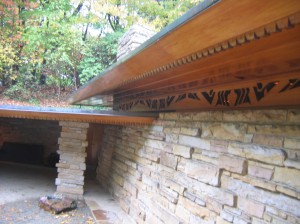
The outdoor spaces are as amazing as the interiors. I especially liked “Bernardine’s reading room” shown in the photo below from a view on the deck.
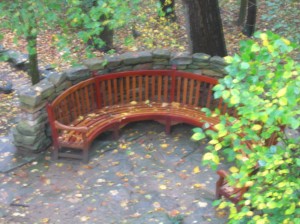
The grounds of Kentuck Knob have one of the best sculpture gardens I’ve ever seen. One of the many pieces that I loved is shown below, a remnant from a London building.
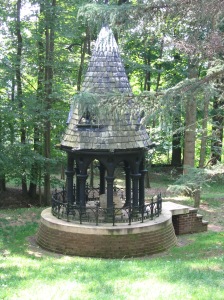
and a pissoire from Paris.
